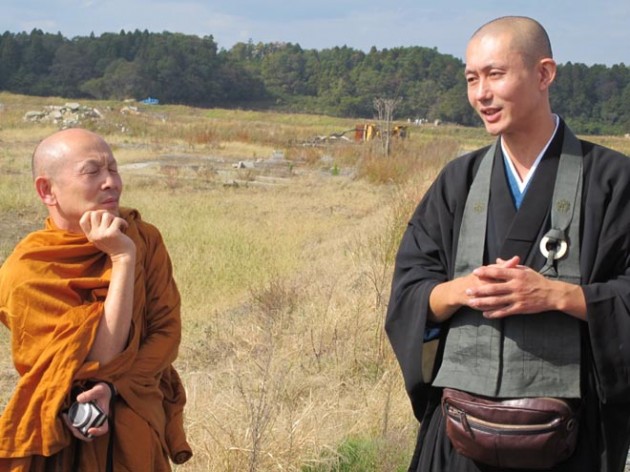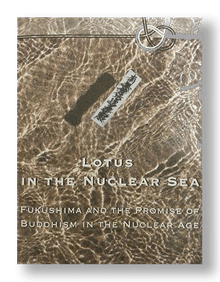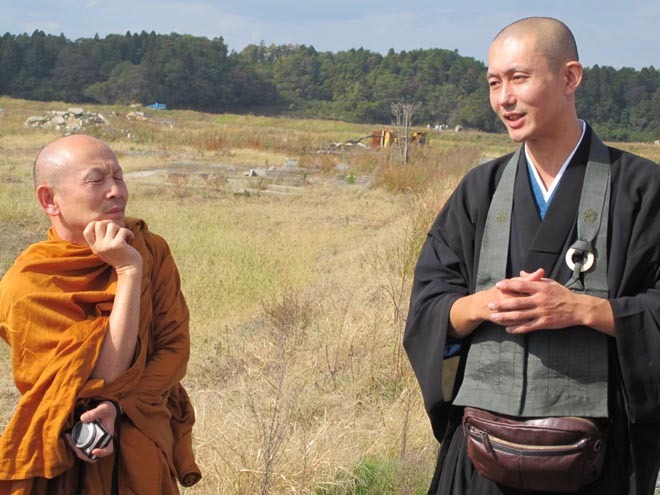

Lotus in the Nuclear Sea: Fukushima and the Promise of Buddhism in the Nuclear Age
ed. Jonathan S. Watts, International Buddhist Exchange Center (IBEC), Yokohama, Japan 2013
[I]n a speech given in Indianapolis in 1959, US President John F. Kennedy commented that the Chinese characters for “crisis” also spell out “opportunity.” This trope was promptly adopted by subsequent speechwriters, leading to redeliveries by Richard Nixon, Al Gore (multiple references), and even Condoleeza Rice. However, when scrutinized, the written characters in question turn out to also have numerous other more mundane readings, and the rhetorical gem crumbles into a convenient truism.
All rhetoric aside however, as a world-scale crisis, the Fukushima triple disaster undoubtedly represents a vital opportunity for fundamental reconsideration of a former status quo. Kyoto Journal’s Fresh Currents, published in 2012, investigated how Japan went nuclear, and charted clearly the potential for the nation to reset its energy policy by moving to fully sustainable sources. A Fresh Currents contributor, Jonathan S. Watts, now has two books out, This Precious Life: Buddhist Tsunami Relief and Anti-Nuclear Activism in Post 3/11 Japan, and Lotus in the Nuclear Sea: Fukushima and the Promise of Buddhism in the Nuclear Age, documenting the post-Fukushima efforts of engaged Buddhists and Buddhist organizations (including the Inter Faith Forum for the Review of National Nuclear Policy, The Religious and Scholarly Eco Initiative and the Religious Based Solar Power Generators Association, and Think Sangha, among others). Despite considerable inertia in a religion well known for its conservatism, his protagonists are seizing this opportunity to apply Buddhist values in opposition to nuclear power, and also to respond to the crisis in ways that invest Buddhist values with new relevance to contemporary society.

Beginning his editor’s foreword to Lotus in the Nuclear Sea, Watts lays out the essential premise as follows:
“Fukushima 3/11 has become a watershed; a moment when it became very apparent that the sacrifices of modern industrial development had outpaced the benefits. While Japan became the first Asian nation to achieve a high level of modern development, it accomplished this feat by dismantling its intimate rural communities and ancient cultural traditions for alienated urban life based on workaholism, consumerism, and the endless drive for growth and success. Its rich natural environment has been slowly compromised in this process with the present specter of nationwide nuclear contamination endangering life itself.”
Formerly known primarily for officiating at funerals and memorial services, many priests of temples in the affected areas now out of necessity embrace caring for the living survivors and evacuees, helping them to deal with crushing burdens of loss, physical and mental suffering, stress, and fears of an uncertain future. Does this mean simply preaching dry dogma of ascetic non-attachment to people devastated by the loss of family members and friends, their homes, livelihoods, former communities, family stability, and even self-identity? Not exactly. While working as facilitators and counselors to alleviate immediate suffering, these priests are also considering its deeper causes, and trying to proactively find practical solutions to Japan’s excessive dependence on nuclear technology (which some apparently see as a karmic consequence of Japan’s post-war materialism). In effect, the disaster has provided the means for Buddhism to present old and generally neglected wisdom in the search for new solutions, beyond an emergency response to local circumstances.
Lotus in the Nuclear Sea is in three sections: the first presents straight talk by Tohoku residents directly impacted by the disaster and relocation; the second, the experiences of Buddhist priests who have been working actively in response to community needs and nuclear-related issues, together with related news stories; and the third, more contemplative essays by Buddhist practitioners from Japan, Asia and the West, including board members of the International Network of Engaged Buddhists (INEB) who visited Japan in November 2012. A statement made by INEB at that time includes the following key point, phrased straightforwardly in Buddhist terms:
“Nuclear energy is an unsustainable and unsuitable form of energy generation that endangers not only those presently alive but future generations. Belief in the power of such technology to bring us prosperity and lasting happiness is a form of ignorance and delusion.”
Both explicit and implicit in much of this book is the context of application of the Four Noble Truths of Buddhism, as stated by Thai monk Ven. Paisan Visalo: “To identify what is the suffering in modern society and what are the root causes, both structurally and spiritually; then to present a vision of a better life that is free from suffering in terms of both the individual and society; and finally to provide the tools to attain this vision.” (See article, KJ 79).
As Joanna Macy says in her essay, “The Promise of Buddhism in the Nuclear Age: Guardianship of Life on Earth”: “Like the Buddha Dharma, the Nuclear Age teaches our essential non-separateness from each other and all that is. Both teach the vastness of our mutual responsibility.”
To suggest the scope of this book, a few quotations connecting with various aspects of the debate:
On ethical conduct: “We must choose a path in which personal happiness is harmonized with human welfare, instead of wishing for prosperity at the expense of others.”
—from a declaration by the national Japan Buddhist Federation (JBF)
On commitment and hope: “My family and I for the time being have returned to Fukushima. However, as the rate of leukemia around Chernobyl suddenly rose five years after the incident, the evacuation zone may yet again widen, and it is quite possible that we may have to evacuate again… If it is possible to stay and continue to rebuild our community and our local networks, I think the temple will play a central role. In Japan, Buddhist temples number around 76,000. This is actually more than the number of convenience stores.”
—Rev. Tanaka Toku-un, abbot of Dokei-ji temple, located 17 km from the Fukushima nuclear plant
On denial: “In children under 18, the normal rate of thyroid cancer is one in one million. However, in only two years, since the incident, we have had 12 confirmed cases in Fukushima, and 16 suspected, in a population of only 170,000 people. Another six months later, in August 2013, the number had jumped to 18 confirmed cancers, and another 26 suspected. The Japanese government is trying to belittle this information by saying that four to five years after the Chernobyl incident the increase in thyroid cancer for young people was only 1 in 10,000 and that it is not possible for such an outbreak of thyroid cancer in just one or two years after the Fukushima incident.
—Rev. Okochi Hidehito, “Deconstructing the Myths of Nuclear Energy and Building a Pure Land without Nuclear or Military Presence”
On adaptation: “Rev. Matsui Soeki, the Secretary General of the Rinzai Myoshin-ji Zen Denomination in Japan, announced during the convening of the denomination’s national Hanazono Association at the headquarters of the sect on January 25th the creation of a new ‘No Nuclear Support Expense’ item as part of the revised regular budget for the denomination for fiscal year 2012-2013 as well as the installation of a solar energy system at the head temple as part of the practice of non-reliance on nuclear energy.”
—January 29, 2013, reprinted from the Chugai Nippo newspaper
A warning: “The great fear is forgetting. The aim of the government and Tokyo Electric Power Company (TEPCO) is for the issue to fade away.”
—Rev. Yoshioka Munenori, a Soto Zen priest from Fukushima City
On exploitation: “Rev. Nakajima and other priests living in rural areas all over the nation also came to experience first-hand the decimation of their local economies. They were able to understand the structural violence of the modern industrial growth paradigm: the systematic destruction of local self-sufficient economies with subsidies for hosting these reactors; the forcing of their populations to migrate to urban areas to work in the industrial sector; and the replacement with local economies addicted to subsidies that eventually run out and necessitate the further building of new plants. The creation of an economic system based on the business of energy, rather than satisfying real energy needs, has become an embodiment of the Buddhist lower realm of hungry ghosts (Jp. gaki, Skt. preta) — an endless and insatiable cycle of greed.”
— Jonathan S. Watts, “A Buddhist Roadmap to Engaging with Nuclear Energy”
Historical context: “The nuclear waste needing disposal by the reactors in Wakasa Bay over the past 40 years is 400,000 times more than the bomb dropped on Hiroshima, while the total waste of all the nuclear reactors in Japan over this time is 1.2 million times that of the Hiroshima bomb.”
—Rev. Nakajima Tetsuen, of Myotsu-ji in Fukui prefecture, a prominent anti-nuke activist since the late 1960s
On obstacles to responsible policy-making: “Recent research by sociologists, psychologists and even economists suggests that once a basic level of income has been achieved, what makes people happy is not more consumption but the quality of one’s relationships with other people. Then why do we remain so committed to a dysfunctional economic process, which among other problems requires so much energy to keep producing unnecessary products? The basic challenge, of course, is that the people who benefit most (in the short term) from the present system are also the economic and political leaders who control it.”
—David R. Loy (a frequent KJ contributor), “The Three Nuclear Poisons.”
On crisis opportunism: “At the time of the Great Hanshin Earthquake in 1995, 20 million tons of wreckage and debris were disposed of in that region of Osaka and Kobe. The price of that debris at that time was 22,000 yen ($230)/ton, but in this disaster the price has become 63,000 yen ($660)/ton. When you come to learn that the total value of this wreckage is some 1 trillion yen (over $10 billion), you understand clearly how the structure of vested interests of those in power has moved into action.”
—Rev. Osada Hiraoki, author of the following Japanese language publications: Emancipation from the Demonic Myth of Atomic Power and co-author of Nuclear Power Steals Life and The Crisis of Nuclear Power and Total Nuclear Contamination.
A reality check: “‘Which sayings of Shinran (1173-1263) form the basis for opposing nuclear energy?’ and ‘Among the teachings of Buddhism, in what way can we explain the problem of nuclear energy?’ These are the kinds of questions that have been cropping up often in my Japanese Pure Land Buddhist denomination since the Fukushima incident of March 2011. In the discourses of the Buddha and the words of Shinran, there are, of course, no references to ‘nuclear energy,’ and the people who ask these aforementioned questions already know that. In this way, I feel there is a clear difference between ‘studying about Buddhism’ and ‘learning from Buddhism’ in regards to the way such questions are framed.
—Rev. Osada Hiraoki, “Nuclear Energy is Actually the Establishment of Self”
Pragmatism: “In the late 1990s, our ECNG (Edogawa Citizens Network for Thinking about Global Warming) began to develop an environmental development scheme that involved installing solar panels on the roof of one of my temples. Our vision was not to make the temple the center of electrical generation that would control and disseminate energy to the community. Rather, my temple has been acting as a model for individual household energy generation and consumption — that is, cyclical energy independence on the lowest level possible. Through the fundraising campaign to install these panels, we launched a community micro credit bank called the “Future Bank.” This bank began supporting community members to purchase new, energy efficient appliances — a cost efficiency factor we found to exceed the investment in installing solar panels.”
—Rev. Okochi Hidehito, “Deconstructing the Myths of Nuclear Energy and Building a Pure Land without Nuclear or Military Presence,” (see also Fresh Currents, “Engaged Buddhism.”)
Also reported is the Nipponzan Myohoji Dhammayatra of Life (a 6-month drumming and chanting “peace walk” from Fukushima to Hiroshima), which is planned to be held again this year. In early planning stages for September 2014 is also a public international symposium in Kyoto, “Societies of Sustainability and Sufficiency,” to be held by the International Network of Engaged Buddhists (INEB) in partnership with the Japan Network of Engaged Buddhists (JNEB) and the Interfaith Forum for the Review of National Nuclear Policy Japan (with related events expected to be held in Minami-Soma, Tokyo, and Fukui).
Buddhahood is characterized as a state of being fully awakened. Lotus in the Nuclear Sea provides an eye-opening primer to Japanese Buddhism’s ongoing reawakening.
